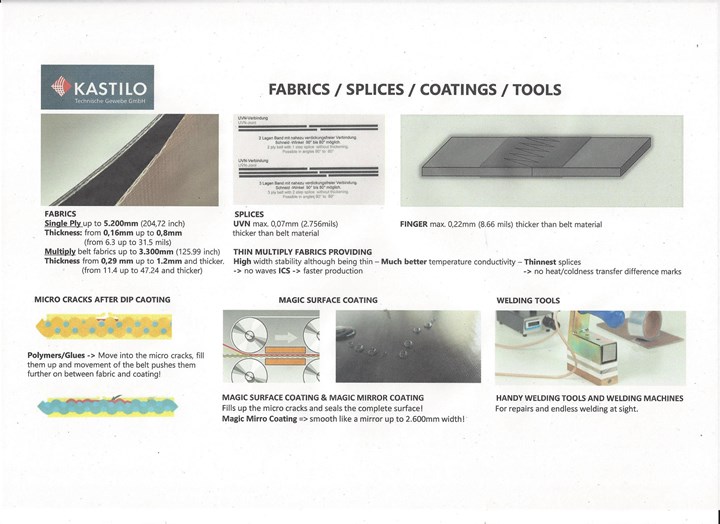CAMX 2022 exhibit preview: Kastilo Technical Fabrics GmbH
Kastilo highlights its specialization in PTFE-coated fabrics and belts, including its Magic Surface film lamination coating and PTFE-coated Multiple fabric/belts.
Kastilo Technical Fabrics GmbH (Ulm-Einsingen, Germany) is known for its high-quality and innovative manufacturing technologies, particularly its polytetrafluorethylene (PTFE) and silicone-coated glass and aramid fabrics, as well as conveyor belts, which are designed based on individual customer and application requirements.
The company specifically highlights its Magic Surface coating, a film lamination for standard PTFE-coated fabrics and belts. The film coating seals any microcracks or other imperfections in the PTFE dip-coated surface to avoid material sticking, the company says. Magic Surface provides a high release, easy cleaning and long coating life when polyurethane, polyethylene, sticky chemicals like EVAs and other glues and chemicals are in use. Magic Surface is applicable for products developed in the automotive, chemical, composites, hygenic, pharmaceutical and recycling industries
High width stability and very good thermal conductivity are features needed for the production process of composite products, Kastilo points out, especially composite boards. PTFE-coated single-ply fabrics need to be thicker for a good width stability but the thicker the fabric, the lower the thermal conductivity. Kastilo highlights its PTFE-coated Multiply fabrics/belts to solve this challenge. With widths up to 125.9", the company says the fabrics are much thinner — to achieve required thermal conductivity — but also have a high width stability due to Kastilo’s undisclosed laminating process for a strong material.
Other materials like PTFE-coated open mesh fabrics with opening sizes of 2x2 mm, 4x3 mm, 4x4 mm and 6x6 mm and up to 204" in width are available. According to Kastilo, these fabircs are needed to prepare the composite material components and nonwoven fleece and felts through a dryer for thermobonding. The wider the belt fabric, the more stability is needed to keep the belt flat. The company’s double weft yarn fabrics give a high width stability for an even product outcome.
Related Content
-
PEEK vs. PEKK vs. PAEK and continuous compression molding
Suppliers of thermoplastics and carbon fiber chime in regarding PEEK vs. PEKK, and now PAEK, as well as in-situ consolidation — the supply chain for thermoplastic tape composites continues to evolve.
-
The potential for thermoplastic composite nacelles
Collins Aerospace draws on global team, decades of experience to demonstrate large, curved AFP and welded structures for the next generation of aircraft.
-
McLaren celebrates 10 years of the McLaren P1 hybrid hypercar
Lightweight carbon fiber construction, Formula 1-inspired aerodynamics and high-performance hybrid powertrain technologies hallmark this hybrid vehicle, serve as a springboard for new race cars.














